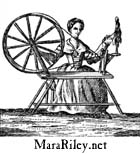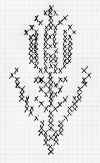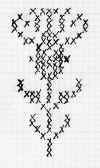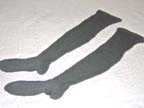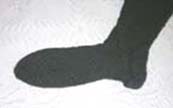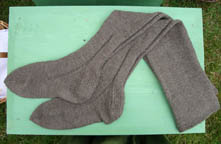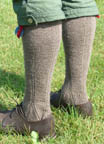
Caveat: I've knitted one pair of period stockings, working on my second pair now, in between working on other projects. These are notes I've made while researching the subject.
Chart for making your own custom knitting pattern:
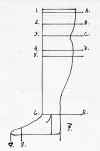
Gauge, or Stitches per inch:
Stocking gauge varies from the 5
to 6 stitches per inch reported from the Machault shipwreck in New France or the
8 stitches per inch of the Gunnister man's stockings (Pulliam, p. 31) through 9 st./in. (Gehret), 12 st./in. (Gehret, Burnston)
all the way up to much finer gauges in the range of 22 st./in. for very
fine stockings; but that certainly takes us beyond the realm of 'common'
stockings. The very finest gauge stockings were almost certainly knitted
by machine (knitted flat, with increases and decreases along the edges
for shaping, then sewn together). 18th century knitting machines could
knit in gauges from 10 to 30 stitches per inch. Coarser
gauges (as low as 2.5 st./in.) were used for items such as mittens and
hats.
You will want to knit a swatch to figure out your final gauge. Knit a circular swatch rather than a flat swatch if you are knitting in the round; most people purl at a slightly different gauge, which will throw off your calculations. It may be advisable to knit a pair of modern socks with the needles and yarn you intend to use for your period stockings to make sure your measurements will give you a good fit.
Yarn:
Worsted wool, cotton, linen, and silk were all used. Common stockings were usually knitted out of worsted yarn, i.e., yarn
spun from combed rather than carded wool. Wool spun this way has a harder
finish than carded wool, because the fibers are all lined up in the direction
of the spinning, so they have less loft (i.e., aren't as fluffy), whereas
yarn that is carded has the fibers lined up perpendicular to the direction
of spin (very fluffy). To understand the difference, think about the finish
on a man's wool suit (combed), as compared with wool for knitting sweaters
(carded).
I ultimately want to knit my stockings using yarn that I have spun, but I may order some yarn for my first pair of period stockings. Knitters on the Historic Knitting list recommend various sport weight or lace weight yarns (two ply, not singles). It will probably be easier to knit your first pair of stockings in wool rather than linen, silk or cotton, since wool has more give and is easier to knit. A pair of stockings may take anywhere from about 8 to14 oz. of wool yarn, depending on gauge and the size of the stockings, but ordering extra yarn is always a good idea. This page has tips on calculating yardage. You can also use a McMorran Balance to calculate the yardage of your homespun yarn.
William Booth, Draper is selling yarns that correspond to period descriptions; Brown Sheep's Nature Spun fingering or sport weight yarn (available from The Mannings and Halcyon Yarn) is also a good choice. Baby Ull is a good Superwash (i.e. washable wool) yarn. There are numerous other sport or fingering-weight yarns that would also work for period stockings.
Colors:
Black, white, and blue were common colors, with blue being a particularly
common color among the working classes. Other colors include brown (dark
to tan), gray, and "sheep's black" (actually a brownish black),
"cloth colored" (natural tannish-white yarn), and speckled or
'clouded' (made by plying two colors of yarn together). Bright colors
such as red, yellow and purple were not unknown, but may have been more
common for silk stockings rather than worsted wool. There is some debate
in reenacting circles about the color green, but Farrell has several references
to green silk stockings in the 17th and 18th centuries.
Through 1730, stocking colors usually complemented the color of the suit or dress; after that date, white stockings were generally worn with formal dress. At the very end of the century (1790s) very fancy striped stockings become fashionable; with the exception of a possible example worn by a sailor in a mid-18th c. illustration, striped stockings don't seem to have been common before the end of the 18th century. Ribbed stockings, however, were worn. The ribs were vertical, measuring 3/4" wide (Farrell, p. 31).
There is no documentation behind the rumor that red, green, or yellow stockings denote anything unsavory about the wearer. In fact, there are both green and red stockings with provenance tying them to women of good reputation.
Stockings were patched, had the feet replaced, redyed, etc. to extend their lives (Dunleavy p. 88)
Needles:
Double-pointed metal needles were used in the 18th century for knitting
stockings; bone or wooden needles may have been used for knitting some larger-gauge
items like caps. If you intend to knit at reenacting events, buy needles
that aren't coated with a noticeably non-period color, like pink or mint
green. If your local yarn shop doesn't carry or can't order small-gauge
steel needles (size 3 down to 0000), you can order them from Lacis,
Halcyon
Yarn, The Mannings, or
various other online knitting suppliers. William Booth, Draper and Lacis carry bone knitting needles in various gauges.
You may want to order two pairs of needles in each size, so that you can knit both stockings simultaneously. A few winters ago, I knitted one stocking down to the ankle, then lost my notes on how many rows / increases / decreases I'd made, so rather than waste the yarn, I ripped out all the work and will have to start over.
I knit in the round on five needles (four needles plus the one active needle), since I find it easier to do the math when dividing by four rather than three.
Some knitters recommend removing 10% from your calculations to account for stretch; others recommend measuring your swatch while it's moderately stretched.
Tops:
Ribbing seems to have come into vogue at the very end of the 18th
century. For most of the 18th century, the most common treatment was several rows of garter stitch,
which served to keep the top of the stocking from rolling and from
slipping below the garter. Some stockings were knitted without a welt.
Various designs for the tops of 18th century stockings include:
Three rows purl, two rows knit, two rows purl, one row knit, one row purl,
then plain knitting (Irish stockings, Dunleavy p. 88)
Several rows of garter stich (six, in Burnston p. 100-101 and Pulliam,
p. 30-31)
The welt at the top of the stocking helps keep the top of the stocking from rolling and serves to keep the stocking from slipping down below the garter.
Early 19th century stockings shown in Rural Pennsylvania Clothing have k2, p2 ribbing at the top instead of rows of garter stitch.
This observation on the garter stitch band is courtesy of Colleen Humphreys (thanks, Colleen!), who has examined several extant examples:
"I have seen a few items, so far, with a garter stitch like band...but none of them were actually garter stitch. Mostly they are two or 3 rounds of knit, and then one of purl.
"But that round of purl was turned and knitted! There is even what we call a 'wrap and turn'. You finish a row of knitting, slip a stitch purlwise from left needle to right, pass yarn forward between needles, slip that same stitch back to the left needle. Turn the work, the yarn should now be in back, and knit around (on the inside!) back to the beginning. Repeat that wrap and turn, and you will be back to knitting on the outside.
"I've seen a few extant 18th C knits, and only on one am I certain that they didn't use this technique! Since this is my usual way of doing garter in the round, I'm delighted!"
Back 'Seam':
The back 'seam' on knitted stockings was probably an imitation of the
seam on frame-knit hose, which, of course, had their seam down the
back. In knitted stockings,
the 'seam' helps the knitter to mark the beginning of each round, and
is a convenient place to put increases and decreases.
Cut-and-sewn hose (which don't fit as closely as knitted stockings) were still worn by some in the lower classes into the early 19th century, at which point machine-knitted stockings became cheap enough that cut-and-sewn hose were displaced.
Styles:
purled every row (Dunleavy, p. 88)
purled every other row (Burnston, p. 101)
six-stitch seam (Pulliam, p. 31)
Gussets and Clocks:
Clocks, when present, were worked on both sides of the ankle, not just
one side. Clocks are not always present on commoners' stockings; none of the
sailors' stockings recovered from the wreck of the General Carleton of
Whitby, lost in 1785, had clocks, though one was ribbed at the top. (Babits,
p. 3)
On common stockings, the heel-flap-and-gusset style shown here seems to be fairly common. This gives you a short gusset to the ankle; the longer gussets seen in some 18th c. artwork may be a feature of machine-knitted stockings.
Purl-stitch clocks (Gunnister stockings, Pulliam p. 31) and embroidered clocks were used; a common method was called "plating", in which the design was added using an additional color knitted into the fabric of the stocking. This can be imitated by embroidering the stockings with a duplicate stitch following the shape of the knit stitches.. A rose-and-crown motif was one of the more common designs. When the gore is a different color from the rest of the stocking, the embroidered clocks usually match the color of the gore. Some surviving silk stockings also have clocks embroidered in gold or silver thread.
Clock designs from "Neues Nah und Strictbuch fur das schone Geschlecht" (New Needlework and Knitting Book for the fair sex), 1784. See Farrell, p. 38, for these and other designs.
On a pair of wedding stockings, a knitted gusset extending above ankle, with details such as a zigzag and diamond pattern on either side of the clock in purl stitches, and a rose and tree clock design above it in purl stitches (Burnston, pp. 100-101).
Heels:
The most common treatment seems to have been the 'common heel,' in which the heel flap is folded in half and bound using a three-needle bindoff. However, if you do a modern heel, few people will notice unless you take your socks off.
Some of the stockings from Rural Pennsylvania Clothing have a k1, sl 1 ribbed heel. These stockings are all early 19th century, and I'm not sure if this kind of ribbing is a feature of early 19th century knitting, or whether it's an earlier feature of Pennsylvania Dutch knitting. Two of the stockings shown in the book have the heel turned as mentioned above, while others have a more modern heel turning.
Toes:
Equal decreases on either side of foot (Burnston, p. 101); also called a 'mitten tip' toe. Also see this page on Socks 101. Instead of grafting using Kitchener stitch (which seems to be 19th c.), use a three-needle castoff to bind the toe.
Links to other useful stocking sites:
The Carnamoyle Stockings, by Kass McGann
Hand Knit Hose by Donna Flood Kenton
Knitting Period Stockings, by Drea Leed
Making 18th Century Fitted Stocking by Rebecca Manthey
Museum of London picture of stocking, infant's knitted vest, and mitten
SockKnitters FAQ
The Sock Calculator (for modern stockings; you plug in your knit gauge and measurements)
References:
A History of Hand Knitting by Richard Rutt
Dress in Ireland by Mairead Dunleavy
Fitting and Proper by Sharon Ann Burnston
Gunnister Man's Knitted Posessions, by Pulliam, Deborah. Piecework, September/October 2002. Loveland, CO: Interweave Press.
Rural Pennsylvania Clothing by Ellen J. Gehret
Socks & Stockings by Jeremy Farrell
Eighteenth Century British Sailors' Clothing by Lawrence E. Babits, in Back to Our Roots II: Investigations into the Influences of Immigration and Trade on the Development of 18th Century American Dress, Tidy's Symposium Papers, March 20, 1999
Also see Notes on 18th Century Knitting for books on knitting and other online knitting resources
Thanks to Katheleen Manneke for pointing me to various examples of period knitting, and various others for pointing out errors and typos.
Photos of some stockings knitted using this chart:
These were sent to me by Jane Atkinson (nice work, Jane!):
Here's a pair I knitted (with a modern heel, per request):
![]()
